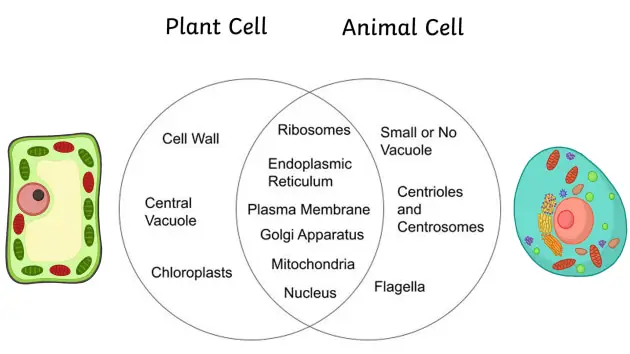In both plant and animal cells, the organelle that is commonly seen is mitochondria. Mitochondria are responsible for producing energy within the cell, and they perform this function in both plant and animal cells. Other organelles that are found in both plant and animal cells include the nucleus, endoplasmic reticulum, Golgi apparatus, lysosomes, and peroxisomes.
List of Organelles that are Present in both Plant and Animal Cells
Cell Membrane
The cell membrane is a thin layer of lipid molecules that surrounds the cell. It acts as a barrier that separates the internal environment of the cell from the external environment. In both plant and animal cells, the cell membrane is present and performs the same function. However, the cell wall is another layer that is present only in plant cells, which gives them a more rigid structure.
Nucleus
The nucleus is the control center of the cell. It contains the genetic material, which is responsible for regulating the cell’s activities. Both plant and animal cells have a nucleus that performs the same function. However, plant cells have a more defined and structured nucleus that is surrounded by a nuclear membrane.
Mitochondria
Mitochondria are organelles that produce energy for the cell. They are often referred to as the powerhouse of the cell. Both plant and animal cells have mitochondria, and they function similarly in both types of cells.
Endoplasmic Reticulum
The endoplasmic reticulum (ER) is a network of membranes that are present in the cytoplasm of the cell. It has two types: rough endoplasmic reticulum (RER) and smooth endoplasmic reticulum (SER). The RER is involved in protein synthesis, while the SER is involved in lipid synthesis. Both plant and animal cells have ER, and they function similarly in both types of cells.
Ribosomes
Ribosomes are small structures that are responsible for protein synthesis. They are present in both plant and animal cells and perform the same function. However, plant cells have more ribosomes than animal cells because they need to produce more proteins.
Golgi Apparatus
The Golgi apparatus is a stack of flattened membranes that are responsible for processing and packaging proteins. Both plant and animal cells have a Golgi apparatus that performs the same function. However, plant cells have more Golgi stacks than animal cells because they need to produce and export more proteins.
Lysosomes
Lysosomes are small sacs of enzymes that are responsible for breaking down waste materials and foreign substances in the cell. Both plant and animal cells have lysosomes that perform the same function.
Vacuoles
Vacuoles are storage structures that are responsible for storing water, nutrients, and waste materials. Both plant and animal cells have vacuoles that perform the same function. However, plant cells have a larger central vacuole, which helps to maintain turgor pressure and provide structural support.
Chloroplasts
Chloroplasts are organelles that are responsible for photosynthesis, the process by which plants convert light energy into chemical energy. Chloroplasts are present only in plant cells and are not found in animal cells.
Similarities and Differences between Plant and Animal Cells
Plant and Animal cells share several similarities with plant cells in terms of organelles. Both types of cells have a cell membrane, nucleus, mitochondria, endoplasmic reticulum, ribosomes, Golgi apparatus, lysosomes, and vacuoles. However, there are also some significant differences.
One of the most noticeable differences is the presence of a cell wall in plant cells. The cell wall is a rigid layer that provides structural support and protection to the plant cell. This is absent in animal cells.
Another major difference is the presence of chloroplasts in plant cells. Chloroplasts are responsible for photosynthesis, the process that produces glucose and oxygen from carbon dioxide and water in the presence of sunlight. Animal cells do not have chloroplasts and cannot carry out photosynthesis.
Plant cells also have a larger central vacuole, which helps to maintain turgor pressure and provide structural support. This is not present in animal cells, although they do have vacuoles that are responsible for storing water, nutrients, and waste materials.
Conclusion
In conclusion, both plant and animal cells have several organelles in common, including the cell membrane, nucleus, mitochondria, endoplasmic reticulum, ribosomes, Golgi apparatus, lysosomes, and vacuoles. However, plant cells have additional organelles like the cell wall and chloroplasts, while animal cells have some unique features like centrioles and lysosomes with different enzyme content. Understanding the functions and differences between these organelles is essential to understanding the cellular processes that sustain life in both plant and animal organisms.
FAQs about What Organelle Is In Both Plant And Animal Cells?
Do plant and animal cells have the same number of organelles?
No, plant cells have additional organelles like the cell wall and chloroplasts, while animal cells have unique features like centrioles.
What is the function of the cell membrane?
The cell membrane is a thin layer of lipid molecules that surrounds the cell, and it acts as a barrier that separates the internal environment of the cell from the external environment.
What is the function of chloroplasts?
Chloroplasts are organelles that are responsible for photosynthesis, the process by which plants convert light energy into chemical energy.
Are lysosomes present in both plant and animal cells?
Yes, lysosomes are present in both plant and animal cells and are responsible for breaking down waste materials and foreign substances in the cell.
Do animal cells have a cell wall?
No, animal cells do not have a cell wall. The cell wall is a rigid layer that provides structural support and protection to the plant cell.
References:
- https://www.toppr.com/ask/question/which-cell-organelles-are-present-in-both-animal-and-plant-cells/
- https://www.sparknotes.com/biology/cellstructure/celldifferences/section1/

I’m Christopher Benjamin, a dedicated Animal Nutritionist at Ethos Veterinary Health with a Bachelor of Science in Animal Science from Michigan State University. My lifelong passion for animals led me to establish AnimalsData.Com. Here, I share expert advice, educational resources, and inspiring stories to empower fellow pet lovers worldwide. Join our community as we celebrate the beauty and diversity of our beloved animal companions!
